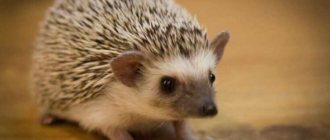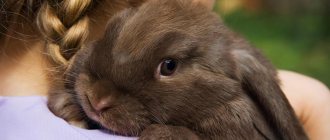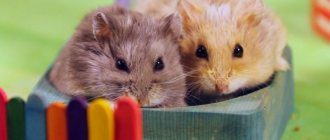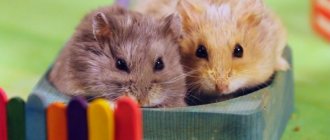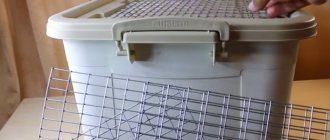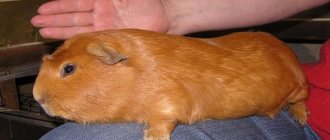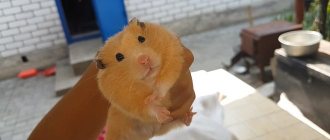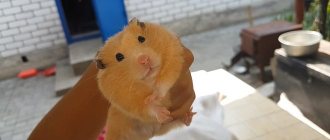For educational purposes, parents often entrust the care of their pet to their child. But children usually don’t know how to care for a hamster correctly. Such a careless attitude often leads to illness or premature death of the animal. Therefore, owners need to study all the information about it and read the recommendations of experienced breeders regarding keeping hamsters.
Is it possible to walk a hamster outside?
You can let your rodent out for a walk, but take precautions. Only an adult animal that is not afraid of unusual conditions is allowed to be taken outside. It is advisable to let your pet walk in a wide and open space: a lawn, a flower garden, or the courtyard of a private house. The hamster needs to be given the opportunity to run around and stretch its legs. But the owner must carefully monitor the small rodent, making sure that it does not hurt itself, cut itself, get lost, or run away. You literally cannot take your eyes off the hamster: as soon as the owner gapes, the nimble baby disappears.
DIY harness
If you couldn’t buy a harness of the right size, it’s not at all difficult to make one yourself. No special patterns are required, you just need to carefully look at the harness in the photo, measure your hamster and, according to the size, sew equipment for the rodent. There are only a few factors to consider:
- the fastening must be strong and reliable;
- the material should be fabric or leather;
- It is better to sew a leash and harness from material in bright colors. This is not just beautiful and aesthetically pleasing, but also practical - if the leash falls out of your hands, so that it immediately catches your eye;
- The harness should not be too small or too big.
A DIY hamster harness will be more convenient than a purchased one, because it is made to individual measurements.
For those who have mastered sewing a harness, making a leash for a hamster with your own hands will be a simple matter. You will only need to buy a rope or strong braid of a suitable width and sew on a fastener (carabiner).
Must be taken into account! You need to put a harness on your pet at home! If the hamster resists, it should be distracted with a treat.
Once the animal is outside, the harness will no longer worry him so much - he will have other things to do. If your pet, even on the street, tries to wriggle out for a long time, remove the harness, and does not switch to the environment, you should check again whether the equipment is comfortable for him.
If you carefully choose a leash and harness for your pet, a walk down the street will become a real pleasure for your hamster.
homkin.ru
How to properly organize walking a hamster?
How to walk a hamster in the fresh air so that it doesn’t run away, get into trouble, or get injured? If your pet is walking around the front garden, garden or private yard, then you need to make sure that he does not find a loophole in the fence or get out onto a pedestrian street or highway. When releasing an animal from your hands onto the ground, you need to make sure that there are no dogs, cats, rats, crows or other dangerous predators nearby. A hamster is a completely weak and defenseless creature; for predatory animals and birds it can become an easy and tasty prey. Items containing toxic substances and heavy metals should also be removed from the walking area. Painted and varnished wooden products are especially dangerous for your pet. The animal can chew them and get poisoned.
Is a walk necessary?
Your pet hamster should be given the opportunity to lead an active lifestyle. A large cage and ball will help increase physical activity. Jogging around the room or going outside will be beneficial.
Hamsters are naturally curious, but they experience discomfort when their environment changes. Veterinarians recommend regularly letting them out of the cage, letting them run and frolic in nature, but you need to monitor their safety.
A hamster is a small rodent; by nature it is not inclined to become attached to a person and will not come running when called. Therefore, it is worth limiting the area for walking, he will simply run away. Veterinarians say that you can walk your hamster everywhere, you just have to follow a few recommendations and rules.
What plants are dangerous for a hamster?
The owner must carefully ensure that a pet walking in the garden, flower garden or lawn does not inadvertently feast on a poisonous plant. On lawns and front gardens you can find quite a lot of herbaceous and flowering plants that can seriously poison or even kill a small animal. When releasing a rodent into a flower bed or garden, you must first make sure that the following ornamental plants do not grow there:
- hydrangea;
- rhododendron;
- yucca;
- yew;
- caladium;
- oleander;
- black nightshade;
- bean;
- autumn colchicum;
- mountain laurel;
- belladonna.
If the owner thinks that the hamster has tried any of the above plants, then the animal must be immediately taken to the veterinarian. Some garden plants are so poisonous that they can kill a small animal in a matter of minutes. When releasing a rodent into a clearing, lawn, lawn, you need to make sure that the baby does not eat the following wild herbaceous plants:
- lily of the valley;
- whistler;
- celandine;
- buttercup;
- raven eye;
- marigold;
- henbane;
- anemone;
- field poppy;
- hellebore;
- sleep-grass;
- wolf's bast;
- wild rosemary;
- digitalis;
- fern;
- dog parsley;
- Datura-herb;
- sow thistle;
- root fighter.
At home
Before letting your hamster run around the house, you need to remove all sharp and small objects, hide or raise all wires so that the animal does not chew them.
Hamsters have small feet but sharp claws. They calmly climb upholstered furniture and curtains. Make sure your hamster doesn't fall.
You can't leave your hamster alone - he might get stepped on.
You can walk at any time of the day, several times a day, using special devices.
Is it possible to put a hamster in a walking ball?
Pet stores sell special walking balls for rodents with small holes for air. Many owners buy these products for their pets to safely walk outside. Using the ball is simple: the lid opens, a hamster is allowed into the hole, the lid closes, and the animal runs around inside the ball to its heart's content. But it should be borne in mind that walking balls are not intended for small hamsters, but for larger rats. A small animal inside the product may feel uncomfortable and have great difficulty moving. The balls are comfortable, ensure a safe walk, but still limit the freedom of the animal.
Types of leashes
Leashes can be varied:
- leash with collar;
- harness;
- harness-vest;
- walking ball.
A leash with a collar is used for such pets extremely rarely, in cases where the hamster is a large breed. Most often, a hamster collar is used only for decorative purposes (collars with rhinestones, tiny collars with beads, etc. are worn). Taking a hamster for a walk wearing a collar is unreliable; the animal may wriggle out.
hamster leash
A harness is a more reliable option and is recommended for walks. A harness is a piece of equipment that is made of leather and fabric materials and passes through the chest and paws. The simplest type of harness is two small loops connected on the stomach, into which the hamster’s legs are threaded. The clasp and leash are attached to the back of the animal. Getting out of a harness is much more difficult than getting out of a collar.
hamster harness
The harness should be put on so that your little finger fits between the animal’s body and the harness. If you put on such a collar more loosely, the hamster will easily free himself, but if you put it on more tightly, you can harm your pet.
A harness is a vest with a leash attached to the back. A vest harness is considered more reliable than a regular harness. The animal itself feels more comfortable in such a harness.
vest-harness for hamster
Carefully! Collars and harnesses must be securely attached to the leash, otherwise a small animal can simply be lost.
Walking ball - it does not apply to leashes, but this is another suggestion for those who want to walk their hamster.
Typically, this is a plastic ball with holes made for ventilation. Not many owners use such a ball for walking, but in the case of a Djungarian hamster or another dwarf hamster, this is the most convenient solution. If the pet is larger, then it is more convenient to walk on a harness, because the pet does not feel very comfortable in the ball, the space is limited, and there is simply no opportunity to run on the ground. walking ball for hamster
Communication
Hamsters are far from the most sociable rodents, since in nature they live strictly alone. At home, keeping a hamster should also be solitary; if there are several animals, then there should be several cages. Such a pet also does not strive to communicate with the owner, so you will have to spend a lot of time taming an independent rodent.
There are certain rules of communication; if they are not followed, the hamster will show fear and aggression, irritating the owner. In the first days after purchasing the animal, it is better not to disturb it at all, no matter how much you want to cuddle the fluffy little ball. It will take about a week to get used to the new home, and at the same time to the voice and smell of the owner. At this stage, it is recommended to say your pet's name while feeding.
Domestic hamsters differ little in temperament from their wild counterparts; they must be patiently trained to be handled so that communication brings joy to both the owner and the pet. With hamsters, the main remedy is food reinforcement - you need to teach the baby to take a treat from the palm of your hand.
Gradually the rodent will get used to the hand, then it can be pulled out of the cage. Handle the animal with care - the tiny animal can be injured if it jumps out of your hands or is held too tightly. The safest thing to do is to wrap your palms around it, forming a “house”.
Contraindicated:
- wake up the animal;
- take from above, from the back (association with a predator attack);
- make sudden movements (even if bitten, you need to remain calm).
Taming
The first thing you need to teach your pet before walking your hamster is to accustom it to your hands. Only a tame animal can be released outside without fear that it will try to escape. It is better to start taming from the very first months of a rodent’s life.
If he continues to be afraid of hands, then there is one good way: when pouring food for him, you need to leave your hand near the food - in this case, he will definitely sniff it. Two or three days of such feeding - and he will already get used to the smell of a person. Then you can try feeding him directly from your hand. If the baby is not afraid to eat from his master's hands while he is being stroked with one finger on his furry back, he has already become tame.
What to feed your Djungarian hamster?
What to feed your pet and how to care for your dwarf hamster at home? Feeding your pet requires special attention. The baby should eat twice a day - breakfast and dinner
Breakfast should be given as soon as the hamster wakes up, and evening food should be given during the period of activity. A pregnant female should be fed more often - 4 times a day at regular intervals.
In the morning you should prepare protein foods, succulent food, boiled vegetables for the dzhungarik, and in the evening it is better to give dry food, treats for rodents, and porridge.
A hamster's diet must contain:
- dry food intended for domestic rodents;
- nuts, seeds;
- boiled vegetables without starch;
- cereals;
- dried branches of fruit trees;
- berries (seeds removed);
- fruit leaves;
- carob;
- sprouted grains;
- homemade crackers;
- raw vegetables, fruits.
How to care for a dwarf hamster at home can be read in specialized literature. So, the books indicate that twice every 7-10 days it is recommended that babies be given kefir, boiled eggs, low-fat cottage cheese, yogurt, boiled fish, boiled chicken.
Thin, sick hamsters, and pregnant females should additionally be given baby food diluted with water. If your pet has an intestinal disorder, offer your pet glutinous rice porridge, and in case of constipation, add a drop of vegetable oil to the food.
It is strictly forbidden to feed hamsters the following foods:
- garlic, onion;
- butter;
- honey;
- pine branches;
- citrus;
- milk, sour cream;
- kozinaki;
- sausages, sausages;
- cookies, chocolate;
- fruit seeds;
- mint leaves;
- watermelon;
- sugar, salt;
- mushrooms, potatoes.
Before buying a pet, you need to provide your child with information about caring for a dwarf hamster at home. So, if there is a child in the family who will be responsible for looking after the animal, he must be warned about the necessary care measures and feeding requirements.
When choosing food for a small hamster, you need to read the instructions. Food for larger rodents is not suitable for dzhungarikas. They contain completely different products that can harm the health of your furry pet.
Interesting! How to properly care for a parrot at home
Habitat
Caring for hamsters at home begins with purchasing and arranging a cage with all the necessary equipment. But the organization of a hamster’s life does not end there. An animal in a confined space is completely dependent on its owner. Care must be taken to maintain a comfortable temperature in the room all year round.
It doesn’t matter what temperature hamsters live at in nature, at home it should be 20-24 C.
The cage is protected from sunlight, and in hot climates it is recommended to equip the room with air conditioning. The hamster's cage should not be close to the heater.
The air should be fresh and clean, without strong odors and smoke. When ventilating the room, be careful not to create drafts.
Rodents do not tolerate noise well, so do not turn on TV, music or loud household appliances near the cage.
The hamster should not be woken up during the day; it is good if there is a house in the cage so that the pet can hide. Children should be taught how to properly care for a nocturnal animal and be prepared to tolerate noise at night.
Using the wrong bedding
In order for a hamster to feel comfortable and please its owners with its healthy appearance and active games, it needs to choose the right food, change the water often and use the right litter for the cage.
You can find a lot of bad advice on numerous forums on the Internet. For example, that rodents love rags. Bury yourself in them and live there. However, this is not at all true. The rags will quickly absorb dirt and become unhygienic. Besides the fact that it will emit an unpleasant odor, and aromas are important for hamsters.
Other materials such as:
- softwood shavings;
- cat litter.
Good, quality bedding material is very important for your pet. At the pet store you can find:
- Hay. You can not only purchase it, but also prepare it yourself. The hamster will be able to make a nest out of it and even feast on it on occasion. However, its environmental friendliness is not always guaranteed.
- Sawdust. This is an inexpensive and universal litter that is suitable for any rodents. However, due to their very light weight, they will be not only inside the cage, but also outside it.
- Wood pellets. Or pressed sawdust. They absorb odor better than all of the above and are environmentally friendly. However, some types of hamsters will not be comfortable living on the pellets as they are quite large in size. In addition, they contain wood dust, which does not have the best effect on small animals.
- Cellulose filler. Externally, it also looks like granules, but not as large in size as wood. They are the safest and most convenient. But they don't absorb odor so well.
The following compounds are strictly not suitable:
- Newspaper. This filler was used quite widely in the past for lack of anything better. However, printing ink alone can cause irreparable harm to your pet's health.
- Plain paper. The hamster will definitely try it on his teeth and may be injured by the sharp edges.
- Cotton wool. Some people also use this kind of filler, motivated by the fact that it will be a cozy nest. Maybe the house will actually turn out to be quite good, but the fibers of this material can wrap around the paws and cause irreparable harm to the limbs.
The issue of bedding for a small rodent should be taken very seriously.

